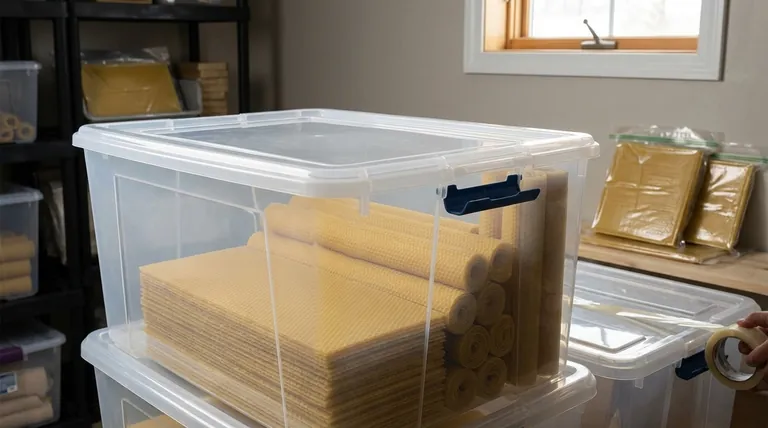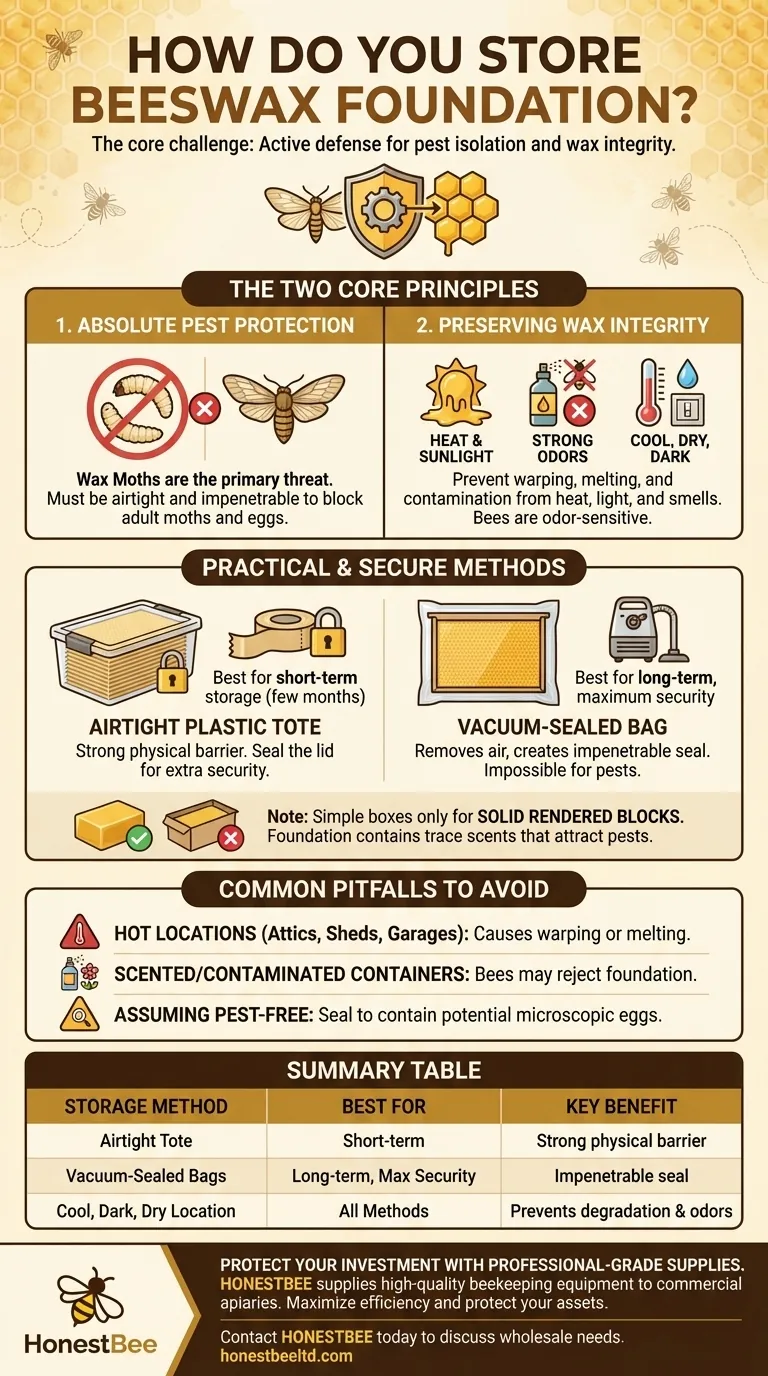To properly store beeswax foundation, you must place it in a durable, airtight container, such as a large plastic tote or a thick, sealable bag. The primary goal is to create an impenetrable barrier against pests like wax moths. Store this container in a cool, dry location away from direct sunlight and strong odors to prevent the wax from warping or becoming contaminated.
The core challenge of storing beeswax foundation isn't just preservation—it's active defense. Your strategy must focus on completely isolating the foundation from wax moths, while also maintaining its physical shape and chemical purity for the bees.

The Two Core Principles of Foundation Storage
Successfully storing your beeswax foundation boils down to protecting it from two distinct threats: pests and environmental degradation.
Principle 1: Absolute Pest Protection
The single greatest threat to stored beeswax foundation is the wax moth. Their larvae feed on beeswax, pollen, and bee cocoons, and they can decimate unprotected frames in a short time.
A simple cardboard box or thin trash bag offers zero protection. Wax moths can easily find or create small openings to lay their eggs.
Your storage must be airtight and impenetrable. This physically blocks adult moths from accessing the foundation to lay eggs.
Principle 2: Preserving Wax Integrity
Beeswax is a stable material, but it's not immune to its environment. Its quality can be compromised by heat, light, and contaminants.
Bees are extremely sensitive to smells. Storing foundation near chemicals, gasoline, or even in scented bags can cause the wax to absorb odors, which may lead to the bees rejecting the foundation later.
High heat can cause the delicate foundation sheets to warp, sag, or even melt. Direct sunlight can also degrade the wax over time. A cool, dark, and dry location like a basement or an indoor closet is ideal.
Practical and Secure Storage Methods
Your choice of method depends on your desired level of security and the duration of storage.
The Airtight Plastic Tote
This is the most common and reliable method for most beekeepers. A large, sturdy plastic tote with a tight-fitting lid creates a strong physical barrier.
For added security, you can run a strip of tape around the lid's seam to ensure it is completely sealed against pests.
The Sealed Bag Method
Using thick, durable plastic bags is another effective option. Standard trash bags are too flimsy and should be avoided.
For maximum protection, especially for long-term storage, consider vacuum-sealing the frames in bags. This removes all air and creates a perfect seal that is impossible for pests to bypass.
Why a Simple Box Isn't Enough
You may see advice that beeswax can be stored in a simple box. This advice applies only to solid, rendered blocks of beeswax.
Pests are not interested in a pure block of wax. However, foundation or drawn comb often contains trace amounts of pollen and other bee-related scents, making it a primary target for wax moths.
Common Pitfalls to Avoid
Mistakes in storage can waste your investment and create problems for your bees down the line.
Mistake: Storing in a Hot Shed or Garage
Never store foundation where temperatures can get high. A hot attic, shed, or garage in the summer can easily lead to warped or melted foundation, rendering it useless.
Mistake: Using Scented or Contaminated Containers
Reusing a container that previously held chemicals or using a scented liner can contaminate the wax. Always use clean, odor-free containers to ensure the bees will accept the foundation.
Mistake: Assuming a Space is "Pest-Free"
Wax moth eggs can be microscopic and may already exist on equipment. Sealing your foundation not only prevents new pests from getting in but also contains any potential infestation, stopping it from spreading.
Making the Right Choice for Your Goal
Select your storage method based on how long you need to protect your foundation and your tolerance for risk.
- If your primary focus is maximum security for long-term storage: Place frames in vacuum-sealed bags and then store those bags inside a sealed plastic tote.
- If your primary focus is convenient, short-term storage (a few months): A high-quality, airtight plastic tote kept in a cool, indoor space is perfectly sufficient.
- If you are storing a solid block of rendered beeswax (not foundation): A simple cardboard box in a clean location is adequate to protect it from dust.
Properly protecting your foundation ensures you are giving your bees a clean, sound, and acceptable base to build upon.
Summary Table:
| Storage Method | Best For | Key Benefit |
|---|---|---|
| Airtight Plastic Tote | Short-term storage (few months) | Strong physical barrier against pests |
| Vacuum-Sealed Bags | Long-term storage, maximum security | Removes air, creates impenetrable seal |
| Cool, Dark, Dry Location | All storage methods | Prevents warping, melting, and odor contamination |
Protect Your Investment with Professional-Grade Supplies
Proper storage is just one part of successful beekeeping. Ensure your operation runs smoothly with durable, reliable equipment designed for commercial success.
HONESTBEE supplies high-quality beekeeping supplies and equipment to commercial apiaries and distributors through our wholesale-focused operations. We help you maximize efficiency and protect your assets.
Contact HONESTBEE today to discuss your wholesale needs and ensure your foundation—and your entire operation—is built on a solid foundation.
Visual Guide

Related Products
- Beeswax Foundation Sheets Beehive Foundation for Wholesale
- Notebook Style Beeswax Foundation Mould Wax Foundation Mold
- Manual Beeswax Comb Foundation Machine Wax Foundation Mill Embossing Machine
- Colorful Silicone Beeswax Foundation Mold Mould for Beekeeping
- Electric Beeswax Foundation Machine With Operating Tray and Wax Foundation Roller
People Also Ask
- What is beeswax foundation used for? A Guide to Efficient Hive Management
- What is 'foundation' in beekeeping, and why is it used? Optimize Hive Management & Honey Production
- What are wax sheets made of? A Guide to Pure Beeswax Foundation for Healthy Hives
- How do beeswax foundations save bees time and energy? Boost Hive Productivity & Honey Yield
- What are the characteristics of beeswax foundation? A Natural Choice for Healthy Hives

















